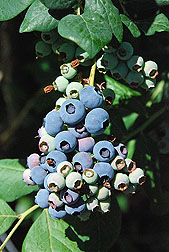This page has been archived and is being provided for reference purposes only. The page is no longer being updated, and therefore, links on the page may be invalid.
| Read the magazine story to find out more. |
|
|
World's Blueberries Protected in Unique, Living Collection
By Marcia WoodMay 5, 2011
Familiar blueberries and their lesser-known wild relatives are safeguarded by U.S. Department of Agriculture (USDA) scientists and curators at America's official blueberry genebank. The plants, collected from throughout the United States and more than two dozen foreign countries, are growing at the USDA Agricultural Research Service National Clonal Germplasm Repository in Corvallis, Ore.
The blueberries are maintained as outdoor plants, potted greenhouse and screenhouse specimens, tissue culture plantlets, or as seeds, according to research leader Kim E. Hummer.
The genebank's purpose is to ensure that these plants, and the diverse genepool that they represent, will be protected for future generations to grow, enjoy, study and improve. For example, plant breeders can use plants in the collection as parents for new and even better blueberries for farm or garden.
Blueberries and several other small berries are among the fruit, nut and specialty crops housed at the Corvallis repository, which in turn is part of a nationwide, ARS-managed network of plant genebanks.
Likely the most comprehensive of its kind in the United States, the blueberry collection nevertheless continues to expand, Hummer reports. Some acquisitions, referred to as accessions, are donations from breeders. Others are acquired through collecting expeditions, which have taken plant explorers to Russia, China, Ecuador and Uruguay, among other places, as well as throughout the United States to find new blueberry plants for the repository.
The collection includes species of wild blueberries native to the Pacific Northwest that have pigmented flesh or pulp. Some breeders are trying to breed some of these species into the familiar highbush blueberry that has a white interior, Hummer noted.
If breeders can put color on the inside of berries through cross-breeding the internal-color berry plants with highbush plants, the breeders may be able to produce a berry that gives fuller color to processed blueberry jams, jellies, juices and dried or frozen fruit.
Other prized specimens at the genebank may someday become landscaping favorites. One example: low-growing Vaccinium praestans from Russia, China and Japan. Also known as redberry Kraznika or rock azalea, it could make an interesting, attractive ground cover that comes complete with edible fruit.
Read more about this and other blueberry research in the May/June 2011 issue of Agricultural Research magazine. ARS is the USDA's chief intramural scientific research agency.

